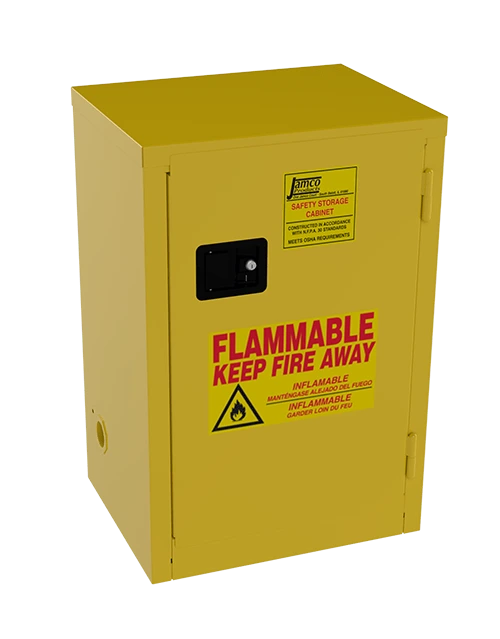
Introduction
Prioritizing safety precautions is crucial when handling flammable liquids. Understanding the associated risks helps prevent accidents, property damage, and loss of life. Our blog post offers valuable insights into safely managing these volatile substances, covering topics such as proper storage, personal protective equipment (PPE), and emergency preparedness. By following these guidelines, you can ensure secure handling, minimize accidents, and protect individuals and property.

Understanding Flammable Liquids
Before delving into safety measures, it’s essential to understand what classifies a liquid as flammable. Flammable liquids have a low flashpoint, which is the temperature at which they can ignite when exposed to an open flame or spark. Common examples of flammable liquids include gasoline, solvents, paints, thinners, and certain chemicals. By their very nature, these liquids pose a higher risk & require extra caution during handling.

Safety Precautions: Before Handling Flammable Liquids
- Conduct a Risk Assessment: Before working with flammable liquids, evaluate the potential risks associated with the task at hand. Identify any hazards, assess the environment, and plan accordingly.
- Ensure Adequate Ventilation: Working in a well-ventilated area helps reduce the concentration of flammable vapors, minimizing the risk of ignition. If necessary, use mechanical ventilation or work in open spaces.
- Eliminate Ignition Sources: Keep flammable liquids away from open flames, sparks, and heat sources. Ensure that electrical equipment in the vicinity is appropriately rated and in good working condition.
- Prepare an Emergency Plan: Develop a comprehensive emergency plan in case of accidents involving flammable liquids. This plan should include evacuation procedures, communication protocols, and the location of fire extinguishers & emergency showers.

Safety Measures: While Handling Flammable Liquids
- Wear Appropriate Personal Protective Equipment (PPE): Always don the necessary PPE, such as safety goggles, gloves, and flame-resistant clothing, to protect yourself from potential hazards.
- Use Approved Containers and Equipment: Only use approved containers and equipment designed for handling flammable liquids. Avoid using makeshift containers that may not provide adequate protection against spills or leaks.
- Practice Good Housekeeping: Keep the workspace clean and organized. Remove any clutter, especially combustible materials, to minimize the risk of accidental fires or spills.
- Handle with Care: When pouring or transferring flammable liquids, do it slowly and carefully to prevent splashing or spilling. Use funnels or appropriate transfer pumps to minimize the risk of contact with skin or clothing.

Proper Storage and Disposal of Flammable Liquids
- Store in Approved Containers: Store flammable liquids in approved, tightly sealed containers specifically designed for their safe storage. Make sure the containers are labeled with the contents & adhere to relevant safety standards.
- Segregate Incompatible Chemicals: To ensure safety, it is crucial to avoid storing flammable liquids in close proximity to chemicals that are incompatible. Proper segregation based on compatibility is necessary to prevent chemical reactions & potential hazards. Refer to the material safety data sheets (MSDS) for guidance on the suitable methods of storage & segregation.
- Ensure Adequate Ventilation: In order to reduce the likelihood of fire or explosion, it is crucial to store flammable liquids in areas that have proper ventilation. Adequate ventilation helps prevent the buildup of flammable vapors. Installing ventilation systems or employing natural methods like opening windows or using fans can effectively dissipate the vapors & maintain a safe environment.
- Avoid Heat Sources and Ignition Points: Keep flammable liquids away from heat sources, open flames, sparks, or ignition points. Store them in cool areas, away from heaters, electrical equipment, and direct sunlight. Ensure that the storage location is free from potential sources of ignition to minimize the risk of fire.
- Implement Secondary Containment: Use secondary containment measures, such as spill containment pallets or trays, to capture any accidental leaks or spills. This helps prevent the spread of flammable liquids & minimizes the risk of environmental contamination or fire hazards.
- Regular Inspections and Maintenance: Ensure that you conduct routine inspections and maintenance tasks. These should involve checking storage areas, containers, and safety equipment for any indications of harm, corrosion, or leakage. Promptly replace any damaged containers or faulty equipment to uphold a secure storage environment.
- Disposal of Flammable Liquids: Follow local regulations & guidelines for the proper disposal of flammable liquids. Contact local waste management authorities or hazardous waste disposal facilities to determine the appropriate disposal methods. Improper disposal can have harmful effects on the environment & human health.
- Educate and Train Employees: Give thorough training sessions to your employees regarding appropriate procedures for storing & disposing of flammable liquids. Highlight the significance of adhering to safety protocols and utilizing personal protective equipment (PPE). Keep your employees informed about any updates in regulations or recommended practices on a regular basis.
By following these guidelines for the proper storage & disposal of flammable liquids, you can significantly reduce the risk of accidents, fires, and environmental hazards.

Handling Flammable Liquids in Specific Environments
Different environments present unique challenges when it comes to handling flammable liquids. Here are some additional precautions to consider:
- Handling Flammable Liquids in the Workplace: In industrial settings, it’s crucial to follow proper protocols & safety guidelines. Ensure that employees are trained on safe handling procedures, use appropriate engineering controls, and establish clear communication channels for reporting incidents or concerns.
- Flammable Liquids in Laboratories: Laboratories often deal with flammable chemicals. Maintain a chemical inventory, labeled containers accurately, and provide fire-resistant cabinets for storage. Implement proper ventilation systems & use fume hoods when working with volatile substances.
- Flammable Liquids at Home: Numerous flammable liquids are frequently present in households, including cleaning agents, paints, and fuels. It is crucial to store these liquids in a cool & well-ventilated area, far from potential ignition sources. To avoid accidents, ensure that containers are properly closed and that these substances are kept out of the reach of children.

Best Practices for Transporting Flammable Liquids
Transporting flammable liquids requires additional precautions to minimize the risk of accidents during transit. Here are some best practices to follow:
- Use Approved Containers: Transport flammable liquids in containers specifically designed & approved for this purpose. Ensure that containers are securely closed & properly labeled with the contents.
- Secure the Load: When transporting flammable liquids by vehicle, secure the load to prevent movement or spillage. Use appropriate restraints & consider secondary containment measures to contain leaks or spills.
- Follow Regulatory Requirements: Familiarize yourself with local & national regulations regarding the transportation of flammable liquids. Adhere to placarding, labeling, and documentation requirements to ensure compliance & safety.

Training and Education
Proper training & education play a crucial role in ensuring the safe handling of flammable liquids. Consider the following:
- Employee Training: Provide comprehensive training to employees who handle flammable liquids. Cover topics such as risk assessment, safe handling practices, emergency procedures, and the proper use of personal protective equipment.
- Ongoing Education: Stay updated on industry best practices, regulations, and advancements in handling flammable liquids. Encourage employees to participate in relevant training programs or seminars to enhance their knowledge & skills.

Common Mistakes to Avoid
To avoid accidents & ensure safety, it’s essential to be aware of common mistakes when handling flammable liquids. Avoid the following pitfalls:
- Poor Storage Practices: Neglecting proper storage guidelines, such as storing flammable liquids near heat sources or in crowded areas, increases the risk of accidents.
- Lack of PPE: Failing to wear appropriate personal protective equipment, such as goggles or flame-resistant clothing, puts individuals at risk of exposure to hazardous substances.
- Improper Disposal: Improperly disposing of flammable liquids, such as pouring them down the drain or throwing them in regular trash bins, can harm the environment & pose a risk to others.
Conclusion
Handling flammable liquids requires utmost care & attention to ensure the safety of individuals, property, and the environment. By understanding the risks, following safety precautions, and implementing best practices, we can minimize the potential for accidents & maintain a secure working environment.

FAQs (Frequently Asked Questions)
Q: Can I store flammable liquids in any container?
A: No, flammable liquids should be stored in approved containers specifically designed for their safe storage. Using inappropriate containers can increase the risk of accidents.
Q: What should I do if a flammable liquid spills?
A: In case of a spill, immediately evacuate the area, alert others, and follow established emergency procedures. If it’s safe to do so, contain the spill using absorbent materials & report the incident to the appropriate authorities.

Q: Are there any special disposal requirements for flammable liquids?
A: Yes, there are special disposal requirements for flammable liquids. Flammable liquids should never be poured down drains, toilets, or regular trash bins. They should be disposed of according to local regulations & guidelines. It is often recommended to contact local waste management authorities or hazardous waste disposal facilities for proper disposal methods.
Q: Are there any special disposal requirements for flammable liquids?
A: Yes, there are special disposal requirements for flammable liquids. Flammable liquids should never be poured down drains, toilets, or regular trash bins. They should be disposed of according to local regulations & guidelines. It is often recommended to contact local waste management authorities or hazardous waste disposal facilities for proper disposal methods.

Q: Can I store different flammable liquids together?
A: It is generally advised against storing different flammable liquids together unless they are compatible & explicitly approved for such storage. Combining certain flammable liquids can result in chemical reactions, heightened volatility, and an increased risk of accidents. To ensure safety, it is recommended to store flammable liquids separately, taking into account their individual characteristics & requirements.
Q: What should I do if a flammable liquid catches fire?
A: If a flammable liquid catches fire, follow the emergency procedures in place. Alert others, evacuate the area, and immediately call emergency services. Do not attempt to extinguish large or uncontrollable fires by yourself unless you have received proper training. Use fire extinguishers or fire suppression systems if it is safe to do so & follow established safety protocols.

Q: Can flammable liquids evaporate?
A: Yes, flammable liquids can evaporate. Flammable liquids have low boiling points, which means they can easily turn into vapor or gas form at room temperature. This is why it is important to store them in well-ventilated areas & ensure proper containment to prevent the buildup of flammable vapors.
Q: Are there alternatives to using flammable liquids?
A: In some cases, there may be alternatives to using flammable liquids. For example, water-based or non-flammable solvents can be used as substitutes for certain cleaning or degreasing applications. It is advisable to explore less hazardous alternatives whenever possible to minimize the risks associated with flammable liquids.

Q: Is it necessary to have fire extinguishers when working with flammable liquids?
A: Yes, it is necessary to have fire extinguishers readily available when working with flammable liquids. Fire extinguishers should be appropriate for the type of fire that may occur, such as Class B fires (involving flammable liquids). Regular maintenance & inspections of fire extinguishers should also be conducted to ensure they are in proper working condition.
Q: Can flammable liquids be transported by air?
A: The transportation of flammable liquids by air is subject to strict regulations & guidelines. The International Air Transport Association (IATA) provides specific rules for the packaging, labeling, and documentation of hazardous materials, including flammable liquids, for air transportation. It is essential to comply with these regulations & work with authorized carriers who specialize in the transportation of dangerous goods.



5 thoughts on “Safely Handling Flammable Liquids: Fueling Safety Tips”